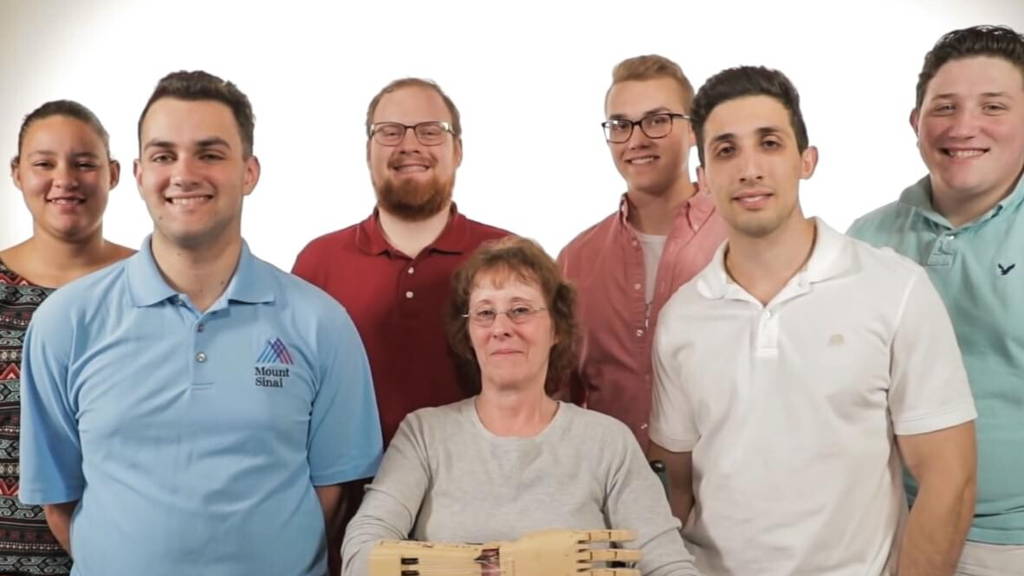A group of six Binghamton University biomedical engineering students launched a collaboration to create a functional biomechanical hand using 3D printing technology one year ago. Since then, they have worked together with an amputee who lost her hand 37 years ago: Susan Reigel, 55, who has worked as a campus dining services employee at the University for the past three years.
The student team includes six seniors, all majoring in biomedical engineering and all graduating from Binghamton University, on May 20th: Adam Adler; Jacob Praga; Jacob Vogel; Trey McIntyre; Victoria D’ambrosio; and Nico Summa. According to Professor Catalano, the university’s biomedical engineering department hasn’t been involved in prosthetics before, so these six undergrad students teamed up for the project as a way to pursue a new focus in an area of professional interest to them, which also has much potential to help others.
Dr. George Catalano, professor of biomedical engineering, oversaw the student-driven project.
Catalano helped guide the student team through the design process and made sure they met all necessary deadlines.
Sue Reigel’s new hand was completed in April, and is going through some final aesthetic improvements. “With her new hand, she will be able to hold at least 10 pounds while maintaining full mechanical and electrical functionality,” says team member Nico Summa. “The fields of 3D printing and prosthetics are rapidly expanding, and access to printable prosthetic designs and 3D printers is becoming more common across the globe,” Summa says. “We will be covering the prosthetic with a silicone ‘glove’ moulded to fit the prosthetic that will act as an artificial skin.
The prosthetic-hand project hasn’t only impacted Sue’s life, but it has changed the lives and minds of the six students working on it. “The project has changed my entire perspective on biomedical engineering,” says Victoria D’ambrosio. “Prior to working with the group, I was more geared towards research…however, working with Sue has opened my eyes to a more Samaritan role in the field, where I can give back to the community and witness the immediate implications of innovation.”
This video showcases the team and the recipient of the new prosthetic hand
###stanford###
The student team includes six seniors, all majoring in biomedical engineering and all graduating from Binghamton University, on May 20th: Adam Adler; Jacob Praga; Jacob Vogel; Trey McIntyre; Victoria D’ambrosio; and Nico Summa. According to Professor Catalano, the university’s biomedical engineering department hasn’t been involved in prosthetics before, so these six undergrad students teamed up for the project as a way to pursue a new focus in an area of professional interest to them, which also has much potential to help others.
Dr. George Catalano, professor of biomedical engineering, oversaw the student-driven project.
Catalano helped guide the student team through the design process and made sure they met all necessary deadlines.
Improving quality of life
“The primary goal of this project was to utilize our team’s various skill sets to collectively design a custom prosthetic for our client—Sue—that would improve her quality of life,” explains student team member Trey McIntyre. “A secondary goal was to create a device that could pioneer the way for a new generation of prosthetics that offer moderate complexity at an affordable price,” adds student Jacob Vogel.Sue Reigel’s new hand was completed in April, and is going through some final aesthetic improvements. “With her new hand, she will be able to hold at least 10 pounds while maintaining full mechanical and electrical functionality,” says team member Nico Summa. “The fields of 3D printing and prosthetics are rapidly expanding, and access to printable prosthetic designs and 3D printers is becoming more common across the globe,” Summa says. “We will be covering the prosthetic with a silicone ‘glove’ moulded to fit the prosthetic that will act as an artificial skin.
The prosthetic-hand project hasn’t only impacted Sue’s life, but it has changed the lives and minds of the six students working on it. “The project has changed my entire perspective on biomedical engineering,” says Victoria D’ambrosio. “Prior to working with the group, I was more geared towards research…however, working with Sue has opened my eyes to a more Samaritan role in the field, where I can give back to the community and witness the immediate implications of innovation.”
This video showcases the team and the recipient of the new prosthetic hand
###stanford###








